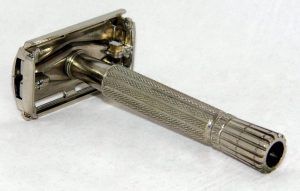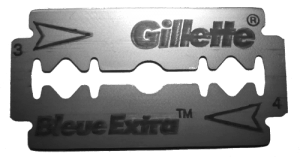You’ll need several things to get started with wet shaving, but the most obvious tools are a razor and blades. There are a lot of options for both, so let’s look at what you need to consider.
Razors
There are essentially two styles of double-edged (DE) razors available – open-comb and safety bar. Technically, only the safety bar style should be called a “safety” razor but a lot of people refer to both styles that way. I’ll refer to them both as safety razors for the rest of this article for the sake of brevity.
An open comb razor has what looks like a comb, or “teeth”, along the two edges of the razor. The purpose of these is to help guide stubble through the “comb” to help the blade cut it. A safety bar razor has a solid bar along each edge that is there to help protect your skin from the edge of the blade.
The degree of aggressiveness varies depending on a lot of things, but typically an open-comb razor is going to be more aggressive on your skin than a safety bar razor will. There are a couple of exceptions to this rule but generally, if you’re new to wet shaving, I recommend starting with a true safety razor – one with a solid safety bar. They tend to be a little more beginner-friendly – the last thing you want to do is start with a really aggressive razor and wind up with a face full of nicks.
Fixed Gap vs Adjustable
The other thing that will determine a razor’s aggressiveness is the blade gap – the distance between the blade and the bottom of the razor. The wider the gap, the more aggressive the shave.
Most safety razors have a fixed gap that is part of the manufacturer’s design. You can get razors with an adjustable gap, however, so you can make them more or less aggressive, depending on your preference. This is another case where I recommend starting with a fixed-gap razor – probably a less-aggressive design – and getting comfortable with how to use it before you start experimenting with an adjustable model.
Design & Assembly
The other major difference between models of razors is how it’s actually put together. In other words, how you replace the blade. There are three styles – one-piece, two-piece and three-piece.
One piece razors are also known as twist to open or TTO designs. They have a butterfly mechanism in the head of the razor that opens up to get at the blade. You typically twist the bottom of the handle to open and close the mechanism. This is the style that comes to mind for a lot of people when they think of safety razors. The most popular razor with this design was probably the Gillette SuperSpeed:

Two-piece razors have the base of the razor attached to the handle and only the top piece can be removed to replace the blade. These are the least common of the three designs.
Three-piece razors are the most common style. There are two pieces to the head of the razor and the handle is also separate. You unscrew the handle and then take the two pieces of the head apart to get at the blade.
Aside from being the easiest to maintain and clean, these models also have the advantage of being able to mix-and-match parts once you get comfortable with wet shaving and want to be a little more adventurous. You can make all kinds of interesting combinations with these “Frankenstein” razors, customizing the look and performance with different manufacturers’ parts.
Razor Blades
The other thing you’re obviously going to need to get started is some blades. As I already mentioned, double-edged (DE) razor blades are dirt cheap compared to the typical multi-bladed cartridges you buy at the drug store. You can get these blades for as little as 20 to 25 cents each so don’t be afraid to experiment with different brands to find one you like.
You’ve likely seen DE blades before, even if you’ve never used one of these types of razors. This is what they look like:

These blades use a standard design so you can be confident they will fit your razor, no matter what brand you buy. At least, I’ve never come across any that didn’t fit precisely.
These blades all look alike but there can be differences in the cutting edge of the blade. Some brands of blade are a little more aggressive than others, so this is another thing that can affect your shave.
Personally, I like the Feather brand of blade. They’re made in Japan and have one of the sharpest edges of any of the brands that I’ve tried.
And I’ve tried a lot.
I recommend buying a bulk pack of blades from various manufacturers to get started. They tend to be cheapest this way and you can try a bunch of different brands to see which ones you like the best.
You can get a sampler pack of 100 blades for about $20 on Amazon from various sellers. The brands of blade vary from one pack to another but they typically include at least 5 or 6 different samples, sometimes considerably more.
I bought a pack of these when I first started wet shaving and I’ve still got some left, 7 or 8 years later. I settled on the Feather brand, so that’s why they’ve lasted me so long, but every now and then I still break out one of the other brands to try something different.
How Often Should You Replace Your Razor Blades?
One of the biggest problems most guys have with shaving can be a problem no matter what type of razor you use – shaving with a dull blade. It doesn’t take long for these blades to lose their edge, and when that happens, you’re much more likely to get nicks, razor burn and irritated skin after shaving.
You should really replace your blade after every three or four shaves to get the best results. But replacing 20 cent blades is a lot easier on the wallet than replacing $2-$3 cartridges.
If you shave every day and replace your blade every four days, at 20 cents a blade you’re going to spend about $23 a year on blades. Compare that to typical multi-blade cartridges at let’s say $2, which is on the low side. You would have to use the same cartridge for an entire month to spend the same amount over a year. If you replaced them every four days, you would spend over $180 a year.
Pretty big difference isn’t it?
Don’t hesitate to replace your blades more often. Your face will thank you for it and you’ll enjoy shaving a lot more.
Single-Edge Razors
While the vast majority of safety razors are the double-edge (DE) design, there are still some single-edge razors out there. These razors use a similar style of blade to their DE cousins but, as you might guess, there is only one cutting edge on the blades.
Single-edge razors have been around for a long time. One of the best known, the Schick Injector, goes all the way back to the 1920’s, although it didn’t really hit its stride until a decade or so later. They were sold up until the 1980’s in North America and right up until the turn of the century in other parts of the world.
In the last few years, there has been a bit of a resurgence in the single-edge razor market, with several manufacturers making new models with modern technology in them.
One of those is OneBlade. They started with a stainless-steel model several years ago and have recently started selling a slightly less expensive version. These razors use single-edge blades from the Feather company, so while they’re not very common in brick-and-mortar stores, they’re easy to find online at reasonable prices.
These razors are targeted mainly at people who shave with the standard multi-blade cartridges you find in most stores. They’ve got some of the same features, such as a pivoting head and a modern design, while offering the advantages of a single blade.
The original stainless-steel version, the OneBlade Genesis, is around $400 so I’ve never really been tempted to pick one up. I’ve been more than happy with my DE razors and couldn’t really see the value in spending that kind of money just to test it out. But now that they have a less expensive version (the OneBlade Core at $69) I thought I’d give it a shot.
There’s a decidedly different feel to it than a typical DE razor. It’s interesting to use something that seems completely new again after so long. Even the second shave felt more natural than the first though, so I don’t expect it will be long before it feels as natural as my go-to razors do.